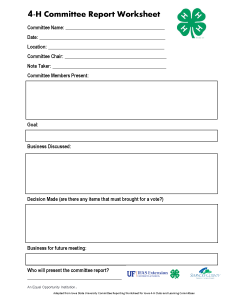4-H encourages youth to take on leadership roles in their clubs and in 4-H Youth County Council. One way is through leading and participating in 4-H Committees. Committees help youth develop skills in communication, decision-making, and teamwork.
Committees serve an important role in the 4-H Youth County Council and 4-H club structure. These groups make recommendations, perform tasks, and develop plans.
What is a committee?
- A small group of 4-H members that meet for a specific purpose or goal.
- A group that shares the work and responsibility among members.
Types of Committees
There are multiple types of committees that serve various functions and meet for different lengths of time.
Standing Committees focus on long-term and complex tasks. They are often on-going, meeting throughout the 4-H year. An example in 4-H Council is the Programs Committee. The Programs Committee decides on the educational programs for the 4-H Youth County Council meetings.
Short-Terms Committees are also known as Program/Activity Committees. These groups meet to plan and execute a specific program, activity, or event. Short-term committees can meet as little as one time. An example in the 4-H Youth County Council structure is the 4-H Thank You Luncheon Committee.
Ad Hoc/ Special Committee are formed for a specific-one time focus. Examples include a fundraising committee or a committee that was formed to plan the 4-H centennial celebration.
Value of Committees
Committees provide youth who are not 4-H Officers an opportunity to participate in leadership. Other benefits include:
- Chance for youth to learn and practice planning and organizational skills.
- Understanding that a group can accomplish more than an individual can on their own.
- Sharing and discussions of different perspectives and ideas.
- Practice in decision-making.
- Sharing of the responsibilities and tasks among team members.
Committee Effectiveness
Multiple factors contribute to a committee being effective.
- Clear Purpose or Goal: The committee has a clearly defined the reason to exist.
- Effective Leadership: Committee Chairs provide leadership to the committee and serve as the point of contact between the committee and the Council. The Chair also facilitates discussion, making sure that all 4-Hers are involved, and that the committee stays on task and schedule.
- Adequate Planning: Including clear objectives, an established timeline, and identifying the responsibilities of each member.
- Regular Communication: Both within the committee and from the committee to the 4-H Club or Council. Reporting back and giving Committee Reports and progress updates to the 4-H Club or Council is important. The 4-H Committee Worksheet allows for notes to be taken during a committee meeting and shared with the 4-H Club or Council.

Interested in participating in a committee and practicing your leadership skills? Join us the first Thursday of the month, 6:30 p.m. to 8:00 p.m. for the Seminole County 4-H Youth County Council Meetings. More information about the University of Florida IFAS Extension Seminole County 4-H program may be found on our website and by following us on Facebook or Instagram.
Ellison, S. and Tesdall, T. (2018). A Guide to the Florida 4-H Council. https://edis.ifas.ufl.edu/publication/4H315. Retrieved September 27, 2023. Kustka, L. (2005). Forming Club Committees. https://fyi.extension.wisc.edu/wi4hpublications/files/2015/10/Forming.pdf. Retrieved September 27, 2023. Kustka, L. (2005). Supporting 4-H Club Committees. https://fyi.extension.wisc.edu/wi4hpublications/supporting-4-h-club-committees/. Retrieved September 27, 2023. Nebraska 4-H. (n.d). 4-H Council Handbook. https://4h.unl.edu/council-handbook. Retrieved October 25, 2023.
 0
0
